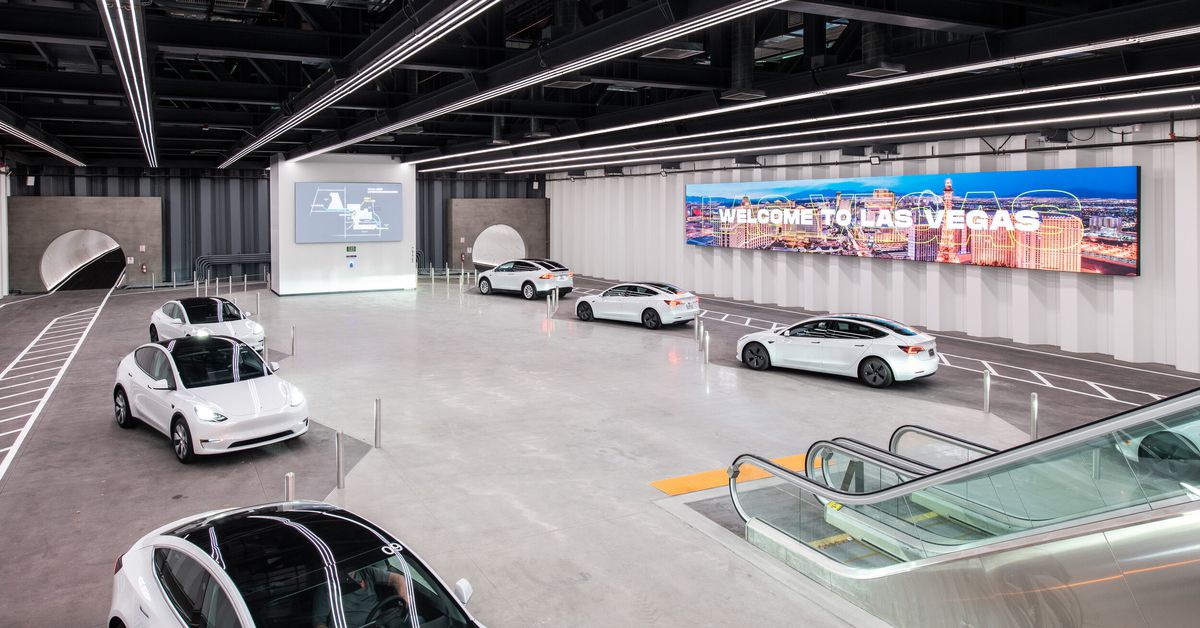The Boring Company tests its ‘Teslas in Tunnels’ system in Las Vegas
Source: The Verge added 26th May 2021Elon Musk’s Boring Company started shuttling passengers through the twin tunnels it built underneath the Las Vegas Convention Center (LVCC) this week, as part of a test to get the system ready for its full debut in June.
Videos, images, and accounts shared around the internet by the people who showed up for the test offer the most coherent glimpse yet at Musk’s solution for traversing the LVCC campus. It is quite literally just Teslas being driven through two 0.8-mile tunnels — a far cry from the autonomous sled-and-shuttle ideas that Musk once proposed for The Boring Company.
There are three stops to the “LVCC Loop” system. The stations at either end are above ground, while the one in the middle is at the same 30-foot depth as the tunnels. The Boring Company used a few dozen Tesla vehicles — including Model 3 sedans, and Model Y and Model X SUVs — during the test. While the company has talked about making riders call for cars using an app, the test only required them to walk up to the next available car. Test riders then hopped in, went to one of the other two stations, and repeated. It appears most riders got between seven or eight to a dozen rides during the test.
Schlepping from one end of the LVCC campus is no quick feat on foot, especially after the Las Vegas Convention and Visitors Authority (LVCVA) recently added a whole new wing. Taxi lines and ride-hailing wait times are notoriously long, too. So any solution that makes it easier to get around the grounds will likely appeal to convention-goers, even if the amenity cost the LVCVA $52.5 million ($48.6 million of which went to The Boring Company).
The Boring Company says the Loop will ultimately turn a 45-minute walk into a two-minute ride, though it’s not down to that level of efficiency yet (hence the test). In one video, one of the test riders said they had to wait about three to five minutes for a few of the rides, though even with a top speed of around 40 miles per hour, trips between stations appear to have taken about a minute to a minute-and-a-half.
One of the things increasing that total travel time was the underground station. There were times when test riders pulled into the station only to run into some congestion. The drivers have to maneuver around other parked Teslas, people getting in and out, and cars queueing up to reenter the tunnels. It’s a tight fit.
There was also just some general confusion as people got used to how the system worked. Passengers were being constantly reminded to leave the doors open when exiting the vehicle to speed up the transition to the next ride. One person got bonked on the head by one of the Model X’s Falcon Wing doors.
The big question with The Boring Company’s efforts in Las Vegas is pretty much the same as it always is with Musk’s ideas: how will it scale? The company says it wants to eventually transport 4,400 people per hour through the LVCC Loop’s tunnels, though TechCrunch discovered documents late last year that seem to show it will only be able to transport 1,200. Beyond the LVCC Loop, The Boring Company wants to build a massive tunnel system that runs under the whole city, including the Las Vegas Strip and the airport. It claims this massively scaled-up version of its underground highway will be able to handle a little more than 50,000 passengers per hour.
The Boring Company has claimed it plans to allow a max speed of 150 miles per hour in these tunnels but has limited speeds during the tests so far. And while the goal is to ultimately have the Teslas drive themselves, the system will rely on human drivers for the foreseeable future.
Reaching that top speed is one of the key things The Boring Company says sets its “Teslas in Tunnels” idea apart from, say, a subway system. (Another is cost, which we’ve seen the company tout in its most recent proposal in Miami.) It likely won’t be attainable unless the company is able to automate the driving, as the tunnels are too tight for a human driver to continuously (and carefully) navigate at such high speeds — another thing that was obvious from videos of the test.
brands: Built Campus Especially Falcon It Key MAX Million New One other Recent Shuttle Vegas WAS media: 'The Verge' keywords: App Elon Musk Internet
Related posts
Notice: Undefined variable: all_related in /var/www/vhosts/rondea.com/httpdocs/wp-content/themes/rondea-2-0/single-article.php on line 88
Notice: Undefined variable: all_related in /var/www/vhosts/rondea.com/httpdocs/wp-content/themes/rondea-2-0/single-article.php on line 88
Related Products
Notice: Undefined variable: all_related in /var/www/vhosts/rondea.com/httpdocs/wp-content/themes/rondea-2-0/single-article.php on line 91
Warning: Invalid argument supplied for foreach() in /var/www/vhosts/rondea.com/httpdocs/wp-content/themes/rondea-2-0/single-article.php on line 91
